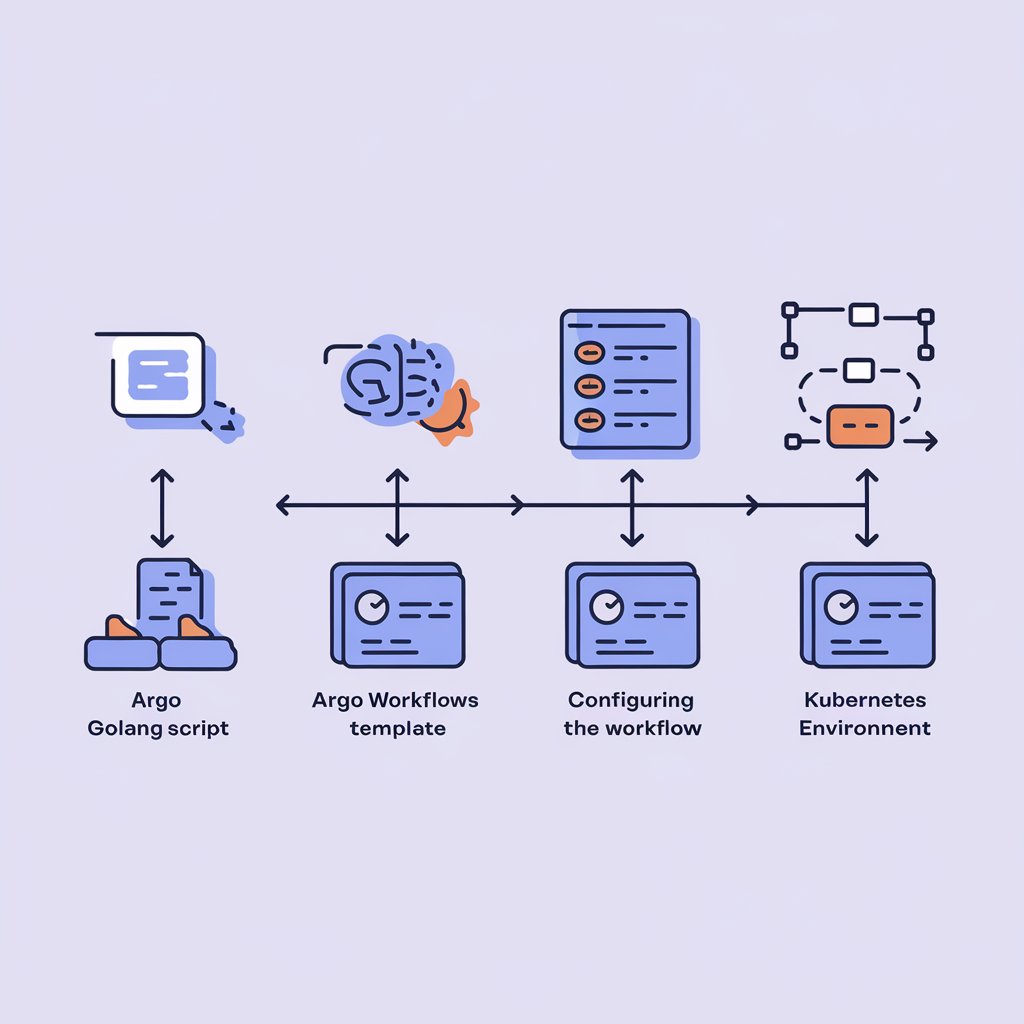Table of Contents
When it comes to automating tasks in a Kubernetes environment, Argo Workflows template to run Golang script offers a powerful and easy solution. Argo Workflows is a tool designed to orchestrate complex workflows, and with its support for Golang, you can automate running scripts with ease. This is especially helpful for developers who want to run their Golang code in a Kubernetes environment without dealing with complicated setups.
In this blog post, we’ll walk you through how to create an Argo Workflows template to run Golang script and get it running smoothly. Whether you’re a beginner or an experienced developer, this guide will simplify the process and give you a hands-on approach to integrating Golang scripts with Argo Workflows in your Kubernetes setup.
Why Use Argo Workflows Template for Running Golang Scripts? A Simple Overview
Argo Workflows is perfect for automating the execution of Golang scripts, especially in a Kubernetes environment. When you use Argo Workflows template to run Golang script, you make your workflow more organized. It takes the burden off developers who would otherwise need to run these scripts manually every time. With Argo, the process is smooth and efficient.
One of the major advantages of using Argo is its ability to handle complex workflows. For example, you can set up steps that run Golang scripts in sequence or parallel. This flexibility makes it easier to manage tasks like testing, deployments, and other critical operations. Computerization is vital to further developing effectiveness and diminishing human mistake.
With Argo Workflows, you can also integrate monitoring and logging, which helps you keep track of how your Golang scripts are performing. This can be a huge benefit for debugging and troubleshooting. The workflow template structure is repeatable, meaning you can run the same tasks multiple times without having to reconfigure everything each time.
Setting Up Your Kubernetes Cluster to Run Golang Scripts with Argo Workflows

To begin using Argo Workflows template to run Golang script, you first need a Kubernetes cluster up and running. Kubernetes helps in managing containers, and it’s where Argo Workflows will operate. Setting up Kubernetes can be done locally using Minikube or through a cloud provider like Google Kubernetes Engine (GKE).
Here’s a step-by-step process for setting up Kubernetes:
- Install kubectl: The kubectl tool allows you to manage your Kubernetes cluster.
- Start your cluster: If using Minikube, you can start your cluster with the command minikube start.
Install Argo Workflows: To install Argo, use the command:
ruby
Copy code
kubectl apply -n argo -f https://raw.githubusercontent.com/argoproj/argo/stable/manifests/install.yaml
- Verify the installation: Run kubectl get pods -n argo to check if everything is working correctly.
Once your Kubernetes cluster and Argo are installed, you are ready to deploy and run Golang scripts with Argo Workflows.
Step-by-Step Guide: Creating an Argo Workflows Template to Run Golang Script
Creating an Argo Workflows template to run Golang script is straightforward once your environment is ready. Here’s how to create a basic template:
- Create a New Workflow File: Start by defining a new YAML file for the workflow. This will contain all the steps and configurations needed for running your Golang script.
- Define Your Golang Script Container: Specify a container image that contains Golang and any necessary libraries to run your script.
- Set Workflow Parameters: You can define inputs, outputs, and other variables that your script needs.
- Run and Monitor: After setting up the workflow, you can deploy it to your Kubernetes cluster and monitor its execution via Argo’s web UI.
This template can be reused for any Golang script you want to execute in the future, saving you time. Once you have it set up, you can automate everything and focus on writing great code.
Configuring Your Argo Workflow to Automatically Run Golang Scripts
Once your basic Argo Workflows template to run Golang script is in place, the next step is to configure it for automatic execution. This allows the workflow to trigger without manual intervention.
- Automate with Triggers: You can set up triggers based on events like a new commit to your Git repository, or when a certain time arrives.
- Set Up Cron Jobs: For running Golang scripts on a schedule, configure CronJobs in Argo Workflows. This allows you to run the scripts periodically, whether daily or hourly.
- Monitoring and Alerts: Make sure to configure alerting systems so you are notified if something goes wrong during the script execution.
These automation features will make your workflow more powerful and reduce the need for constant supervision.
Best Practices for Using Argo Workflows Template to Run Golang Scripts in Production

To get the most out of Argo Workflows template to run Golang script, it’s essential to follow some best practices to ensure smooth and efficient operation in production environments.
- Use Version Control for Templates: Keep your workflow templates under version control using Git. This way, you can easily track changes and roll back if needed.
- Optimize Workflow Steps: Break down workflows into smaller steps to make debugging easier and improve efficiency. Avoid running unnecessary tasks in parallel.
- Resource Management: Ensure that each step of the workflow has enough CPU and memory allocated to prevent failure. Argo permits you to indicate asset demands for every compartment.
- Logging and Monitoring: Always enable detailed logging and monitoring to help debug issues and track performance.
By following these practices, you can ensure that your Golang scripts run smoothly in production and avoid unnecessary downtime.
Scaling Your Golang Scripts with Argo Workflows: Tips for Efficient Execution
As your project grows, you might need to scale the execution of your Argo Workflows template to run Golang script to handle more tasks or run scripts faster. Here are some tips:
- Horizontal Scaling: Increase the number of parallel tasks to speed up execution. Argo Workflows supports running multiple instances of the same task.
- Optimize Container Images: Use smaller, optimized container images to reduce startup time and improve performance.
- Use Caching: Implement caching strategies for Golang dependencies to avoid rebuilding them every time your script runs.
By scaling your workflows, you can improve performance and handle more workloads without running into bottlenecks.
Conclusion
Using an Argo Workflows template to run Golang script makes it much easier to automate tasks in your Kubernetes environment. Whether you’re a beginner or an experienced developer, Argo Workflows offers an organized way to manage your Golang scripts without having to run them manually every time. With its ability to handle complex workflows, you can save time and avoid human errors, improving both efficiency and productivity.
By following the steps in this guide, you can set up a powerful automation system to handle your Golang scripts in just a few clicks. The flexibility of Argo allows you to run scripts on-demand or on a schedule, giving you full control over your development process. With a bit of setup, you’ll soon be able to enjoy the benefits of automation, freeing up your time to focus on more important tasks.
FAQs
Q: What is Argo Workflows?
A: Argo Workflows is an open-source tool that helps you automate tasks by running jobs in containers on Kubernetes. It’s great for managing complex workflows.
Q: Do I need a Kubernetes cluster to use Argo Workflows?
A: Yes, Argo Workflows runs on Kubernetes, so you need a Kubernetes cluster to use it. You can use services like Minikube for local development or cloud providers like GKE.
Q: Can I use Argo Workflows to run Golang scripts?
A: Yes, Argo Workflows can run Golang scripts. You can create a workflow template to execute your Golang code automatically within a Kubernetes cluster
Q: How do I install Argo Workflows?
A: You can install Argo Workflows by running the command kubectl apply -n argo -f https://raw.githubusercontent.com/argoproj/argo/stable/manifests/install.yaml on your Kubernetes cluster
Q: Is Argo Workflows easy to use for beginners?
A: Yes, Argo Workflows has a simple setup process and plenty of documentation to help beginners. Once you follow the basic steps, running Golang scripts becomes easy.
